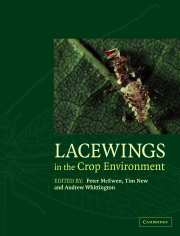Book contents
- Frontmatter
- Contents
- List of contributors
- Preface
- PART 1 Lacewing systematics and ecology
- CHAPTER 1 Introduction to the Neuroptera: what are they and how do they operate?
- CHAPTER 2 Introduction to the systematics and distribution of Coniopterygidae, Hemerobiidae, and Chrysopidae used in pest management
- CHAPTER 3 The common green lacewing (Chrysoperla carnea s. lat.) and the sibling species problem
- CHAPTER 4 Recognition of larval Neuroptera
- CHAPTER 5 Ecology and habitat relationships
- CHAPTER 6 Natural food and feeding habits of lacewings
- CHAPTER 7 Outlines of lacewing development
- PART 2 Lacewings in crops
- PART 3 Principles
- PART 4 Case studies
- PART 5 Conclusion
- Taxonomic index
- General index
CHAPTER 3 - The common green lacewing (Chrysoperla carnea s. lat.) and the sibling species problem
Published online by Cambridge University Press: 04 May 2010
- Frontmatter
- Contents
- List of contributors
- Preface
- PART 1 Lacewing systematics and ecology
- CHAPTER 1 Introduction to the Neuroptera: what are they and how do they operate?
- CHAPTER 2 Introduction to the systematics and distribution of Coniopterygidae, Hemerobiidae, and Chrysopidae used in pest management
- CHAPTER 3 The common green lacewing (Chrysoperla carnea s. lat.) and the sibling species problem
- CHAPTER 4 Recognition of larval Neuroptera
- CHAPTER 5 Ecology and habitat relationships
- CHAPTER 6 Natural food and feeding habits of lacewings
- CHAPTER 7 Outlines of lacewing development
- PART 2 Lacewings in crops
- PART 3 Principles
- PART 4 Case studies
- PART 5 Conclusion
- Taxonomic index
- General index
Summary
INTRODUCTION
Of the many genera of Chrysopidae, Chrysoperla Steinmann is the most important in agricultural programs of biological control (New, 1975; Karelin et al., 1989; Brooks, 1994). Within Chrysoperla, the names of several of its 36 recognised species (Brooks, 1994) figure prominently in the literature of biological control, including C. rufilabris (Burmeister), C. externa (Hagen), C. zastrowi (Esben-Petersen), C. pudica (Navás), and C. congrua (Walker) (Barnes, 1975; Brettell, 1982; Albuquerque et al., 1994; Legaspi et al., 1996). The most frequently used control agent, however, is the common green lacewing, Chrysoperla carnea (Stephens). Long assumed to be a single widespread morphological species with an Holarctic distribution (Tjeder, 1960), ‘C. carnea’ has been mass-reared and released in croplands all over the world, including Europe (Alrouechdi, 1981; Bozsik, 1991; Sengonca et al., 1995), western Asia (Gerling et al., 1997), north Africa (Farag & Bleih, 1991), India (Thierry & Adams, 1992), North America (Ridgway & Jones, 1969; Tauber & Tauber, 1975; Chang et al., 1995; Daane et al., 1996), Central America (Tauber et al., 1997), and even New Zealand (Dumbleton, 1936). However, evidence has been accumulating that ‘C. carnea’ is not a single species, but rather a complex of several to many remarkably similar, cryptic species (Tauber & Tauber, 1973a). This widespread mega-species is now more accurately called the carnea-group, one of four such species-groups into which Chrysoperla has recently been divided (Brooks, 1994).
Conclusions regarding species boundaries and diversity in the carnea-group depend upon species concept (Mayr, 1963;Templeton, 1989).
- Type
- Chapter
- Information
- Lacewings in the Crop Environment , pp. 29 - 42Publisher: Cambridge University PressPrint publication year: 2001
- 31
- Cited by



